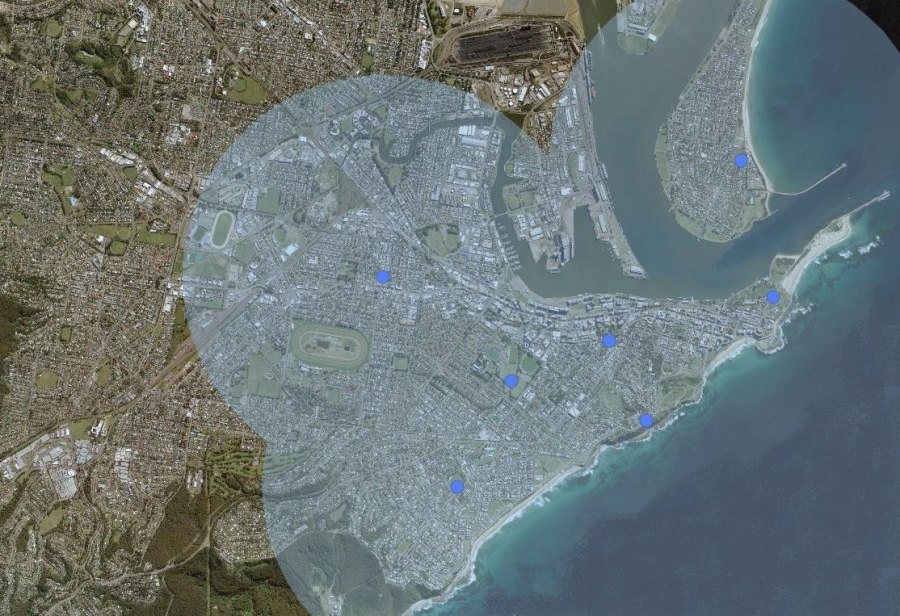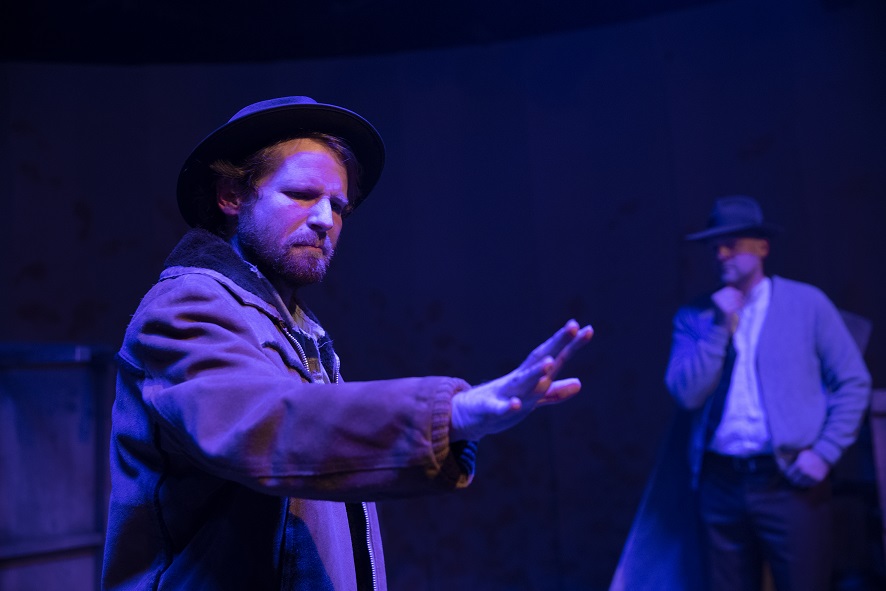Saturday, December 28, 2019
Replace New Year's Eve Fireworks with an App
There have been some calls for new year's eve fireworks to be cancelled in Australia, due to bush-fires. Perhaps they could be replaced, at least in part, by spectators' smart phones. The idea would be to have each person hold up their phone, which would display part of a coordinated pattern. This would be similar top the effect where those in a stadium hold up colored cards on cue, but could form a much faster changing, more vibrant pattern. This could supplement laser light shows and displays projected on buildings. This would also turn people from spectators, into active participants in the show, as well as avoiding setting off pyrotechnics during a total
fire ban.
Friday, December 27, 2019
Carryon Backpack for Travel
 |
| Caribee Sky-Master Carry On Bag |
There is a bewildering rage of carry-on bags. I wanted one which did not have wheels, or a frame, to save weight, and looked more like a bag, than a backpack. Also I wanted one which opened up flat, and ideally, had compartments. With many backpacks you have to stuff clothes in through a narrow opening in the top.
First I purchased a Cotton On Foldable Cabin Bag. This zipps down the middle and opes to reveal two zipped mesh compartments, making it easy to pack. It weighs very little, however it had no backpack straps (just a shoulder strap). Also it is made entirely of fabric, so does not retain its shape, making it more difficult to carry.
Shorty before my trip I purchased the Caribee Sky-Master. Like the Cotton On bag, this zips open and has two mesh covered compartments. One compartment is slightly larger and has compression straps. It also has backpack straps, and a foam plastic back-plate which keeps it in shape. The backpack straps can be concealed in a zippered compartment, and are very comfortable in use. There is a carry handle on one end and on the side, allowing it to be carried as a small suitcase. There is an outer zippered compartment for small items, but I found that I tended to open it too far and they fell out.
While luggage sellers make much of conforming to airline carry-on bag restrictions, when I cam to pack my bag I found that weight, was the limiting factor. My first flight, from Sydney to Singapore, had a limit of 10 kg, which I was able to meet, but the second flight, to Yogyakarta, was limited to 7kg. If you fill a carry-on size bag it is very difficult to get it under 7 kg. At this stage of my travel, my bag had increased to 12 kg, so I purchased extra checked luggage allowance. By the time of my third flight, the bag had got to 20 kg (with all the shopping, and fortunately I had checked baggage with the last ticket.
ps: Caribee might consider making this bag simpler and lighter. The backpack straps could be made removable (as the shoulder strap is). There would then be no need for a zipped compartment on the back to hold the straps. The smaller compartment on the front could be given a lip, so items don't fall out when it is opened, or this could be omitted (this would make security much easier, as the bag with then have just one zip).
Thursday, December 26, 2019
Wireless Active Noise-Cancelling Headphones for Travelling
 |
| Audio-Technica ATH-ANC500BT Noise-Cancelling Headphones |
This is my first pair of cordless headphones and I found it a relief not to wake up on an aircraft entangled in wires. The batteries last long enough for the flight from Sydney to Singapore. The controls are simple: one switch turns on both Bluetooth and the noise reduction function (you don't have a choice of one or the other). There are volume up, down and pause buttons.
 |
| On the Yogyakarta to Jakarta Train |
I did wish the headphones were a little more compact. The ear-cups rotate so they can be laid flat, but they do not hinge in, so are still quite large. I bought the blue, rather than black model, so they would be easier to see in a dark aircraft, but they could do with some bright highlights as they are still hard to see (but does makes them unobtrusive). That said, I have no regrets with this purchase.
Friday, December 20, 2019
Mount Merapi
Mount Merapi is an active volcano near the Indonesian city of Yogyakarta. This photo was taken from the balcony of a hotel downtown, during the TALE 2019 conference. In 2006 I arranged for the Australian Computer Society to fund Indonesia students to work on adapting the Sahana open source disaster management software if needed for an expected eruption of Merapi. Fortunately this did not happen.
Monday, December 16, 2019
Flight over the Australian Desert
Sunday, December 15, 2019
Skytrain Jakarta Airport
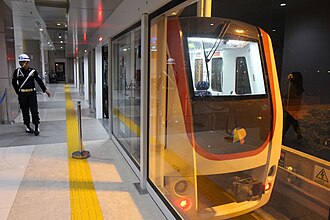 |
| Skytrain (from Wikipedia) |
Terminal 3 is very new and very large: the shuttle stopped in front of what I thought was the front of the building, but when I looked up there was a roof high above us. Facilities are still be installed: the "street food" so far consists of burgers and pizza. There are free showers, but I was not offered a towel, or soap.
Saturday, December 14, 2019
On the Jakarta Airport Train
Greetings from the Jakarta airport train ("Railink") to Soekarno–Hatta International Airport. I took the train from Yogyakarta after the IEEE TALE 2019 engineering education conference, then one stop on a crowded commuter train to transfer to the airport express at Manggarai. The only difficulty was that the station is being rebuilt, so to get from the old commuter platform to the shiny new airport one, I had to balance along the edge of the platform, with busy commuters coming the other way, then walk cross the tracks. I then went up an escalator into a different world of space, and helpful staff. The train appears to have more staff than passengers, the conductor explaining Friday is the peak time. Also the warned me that at Duri the train changes direction. One improvement would be to have the train display the next destination: currently the display tells you the temperature and the speed of the train, which are not as important as where to get off.
On the Yogyakarta to Jakarta Train
 |
| In the dining car |
 |
| Locomotive |
 |
| Small Hut Over Water on the Jararta Line |
Monday, December 09, 2019
Bright lights of Yogyakarta
 |
| Bright lights of Yogyakarta |
 |
| On the bus from Yogyakarta Airport |
Saturday, November 16, 2019
Gov 2.0 Taskforce: Annual "unparliament" at Old Parliament House?
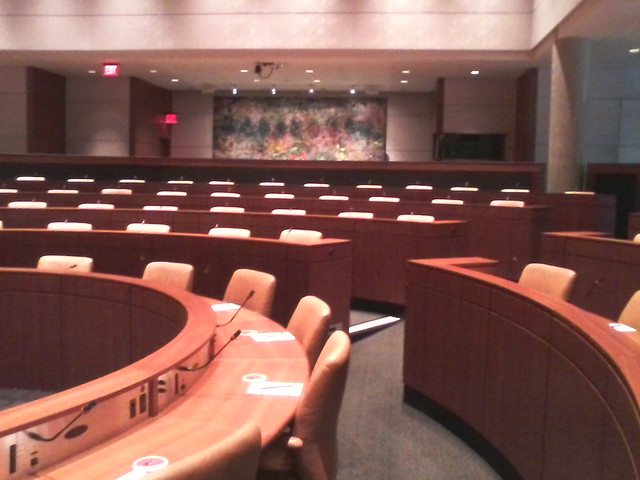 |
| SFU Asia Pacific Hall |
The Simon Fraser University Centre for Dialogue has a purpose designed circular room, the Asia Pacific Hall, for fostering constructive discussion.
 |
| OPH Senate Chamber |
Gov 2.0 Taskforce: Open is Expensive, Not Just Free
At Gov 2.0 Taskforce: Ten Years On, one of the un-conference presentations was on "Open is Expensive, Not Just Free". The essence of this seemed to be pointing out that open access initiatives are usually supported by unpaid volunteers. The implication is that these initiatives can't be maintain, because we can't expect people to keep working for free. I suggest the start-up community has an answer to this. There are models by which people can work on free open products, but still make money from them. One example is "social enterprises". Also start-up centers, such as the Canberra Innovation Network (CBRIN), train people how to build a business case, which includes who is going to pay, and also trains people to ask for money. Also there is The Mill House, which specializes in social enterprises.
There is a live stream and online questions are accepted. From the
There is a live stream and online questions are accepted. From the
Gov 2.0 Taskforce: Recommendations
| Minister's Office, Old Parliament House |
To me this problem of getting anything done in government sounded an old problem. As a public servant,I had to occasionally work around the official processes to get anything done. This was usually with official approval. For these purposes links to academia and the professions are useful. Unfortunately in the Internet age it is very much more difficult to have an off the record, or "other hat" discussion. To that end I have added "Teaching Gov 2.0 to Government" to the list of topics for discussion.
A recent example is that ANU will run the Cyber Bootcamp Project for the Department of Foreign Affairs and Trade. Such courses provide a way for government employees from across governments to have a relatively free discussion. Students can explore ideas as students, then work out how the outcomes can be put to their organizations as initiatives. This also happens in professional bodies, and standards committees.
ps: My old posts from ten years ago are at gov2taskforce
Gov 2.0 Taskforce: Ten Years Done
 |
| Pia Andrews |
ps: My old posts from ten years ago are at gov2taskforce
Gov 2.0 Taskforce: Ten Years Off
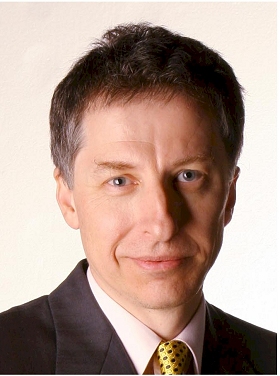 |
| Nicholas Gruen, CEO, Lateral Economics |
At Gov 2.0 Taskforce: Ten Years On, Nicholas Gruen is reflecting on the original intent of the Taskforce and what happened. There is a live stream and online questions are accepted. He showed some "historical artifacts" slides, which showed the excitement and potential of Gov 2.0 ten years ago. One aspect was how outsiders, not from government, could have input. The widespread interest in the report "Engage: getting on with Government 2.0", was its translation into Korean. However DR. Gruen's summary was "We got our recommendations accepted, but then they were not implemented".
Gov 2.0 Taskforce: Ten Years On
Greetings from Old Parliament House in Canberra, where the Director is opening Gov 2.0 Taskforce: Ten Years On. I will be blogging on it throughout the day. There is a live stream and online questions are accepted.
My old posts from ten years ago are at gov2taskforce. Here is the official announcement of the event:
"It has been 10 years since the Gov 2.0 Taskforce handed down it's report. Those were optimistic days, so let's review & plan next steps. ...
About this Event
A few folk who were involved or contributors to the Gov 2.0 Taskforce (2009) thought it might be useful to reflect on the 10 years since the Report was delivered. Those were optimistic days and a strong community formed around the activities and engagement from the Taskforce. The Report recommendations were accepted almost entirely by the Government Response, so 10 years on, how well was the intent and vision of the Report realised, and what do we need to do next?
Our sincere thanks to the Museum for Australian Democracy (and Democracy 2025) for being the venue sponsor and supporter for the event. The event will be hosted at Old Parliament House, the perfect setting!
Thanks also to Cordelta for coming on board as a corporate sponsor and The Mandarin as media sponsor.
The goal of this event is threefold and would involve a diverse crowd that broadly reflects the communities and sectors of Australia:
The event will be in Canberra, where the Taskforce was launched, but people are welcome to create satellite events to connect local communities using the live stream and online tools to contribute to the day.
- To reflect on 10 years since the Gov 2.0 Taskforce Report, progress made or not.
- To identify and articulate the barriers to progress, and consider the old, new and emerging opportunities and threats.
- To (re}energise and activate a diverse community around the goal of better public sectors for a better society, both through reconnecting in this event, and through creating and committing to actions over the coming year.
Please note this event is being run by volunteers, and any feedback, volunteering or support is welcome.
We hope this event helps contribute some momentum to a range of community and cross sector activities. We believe this needs to happen if we are to get the public sector we need. One that is collaborative, resilient, trustworthy, fair and which provides a stable foundation upon which all people can thrive.
Please also book a place in the kids creche if you need it, noting that teenagers are welcome in the event on a normal ticket.
We also have an anonymous survey running to get pre-event feedback to help inform the day, so if you can spare about 10-15 mins, please get a cuppa and participate in the Gov 2.0 Taskforce Recommendations Report Card survey.
The rough agenda is:
Introductions
- 09.30 - Welcome to Country
- 09:40 - Introductions and outline for the day
- 09:45 - Nicholas Gruen reflects on the original intent and hopes/fears of the Taskforce and observations from the last decade.
- 10:00 - What was implemented at the time?
- 10:05 - Government 2.0 as an enabler of citizen led initiatives
- 10:15 - Gov 2.0 Taskforce Report Card - survey result overview
- 10:30 - Report card group session: To reflect on the survey results of progress made on Report recommendations, where we went backwards and what we wouldn’t do. Fully participatory session for attendees to discuss, review and identify what success might look like today..
- 11:00 - Break - BarCamp signups
- 11.20 - Primer talks for barcamp session (10 mins each):
- Gov innovation trends: Alex Roberts reflects on global trends in public sector innovation and his observations of progress in Australia since the Gov 2.0 Taskforce (including with Design Gov).
- Emerging tech and government - what technology trends have or could have the greatest impact for public sectors from the last 10 years?
- 11:40 - BarCamp session: short self-nominated sessions for participants to present ideas about the barriers to progress, new threats and opportunities facing us, and to draw out the hopes and fears for the future.
- 13:00 - Lunch
- 14:00 - Action stations: After participants vote for the topics/themes they want to action, they each go to the “action station” of greatest interest around topics or themes to identify and commit to practical actions and experimentation over the coming year to improve public sectors, to further realise the original intent from the Gov 2.0 Taskforce, and to bring about a better future for all. Teams report their actions into the online tool.
- 15:30 - Reflections from the day and report from action stations.
- 16:00 - Close"
Tuesday, November 12, 2019
Digital Law on Rottnest Island
 |
| Selfie, at Rottnest Hotel |
 |
| Perth in the distance, from the front step of Rottnest Hotel |
Some notes:
Smart contracts
From: Blockchain Challenges for Australia: An ACS Technical Whitepaper, by Nick Addison, Samuel Brooks, Katrina Donaghy, Mark Ebeling, Scott Farrell, Vincent Gramoli, Adrian Lawrence, Marc Portlock, Mick Motion-Wise, Bridie Ohlsson, Beth Patterson, Philippa Ryan, Mark Staples, Ingo Weber, and Tom Worthington, 2019, Australian Computer Society, Page 37 (emphasis added). URL http://bit.ly/acsblock“A smart contract can be defined as an event-driven computer program that executes on an electronic distributed, decentralised, shared and replicated ledger used to automate transactions. Even where a smart contract is not technically a ‘contract at law’, it may give rise to obligations and remedies that sound like a contract in law.”
Blockchain Challenges, ACS 2019
Protecting Smart Contracts
From: Fuzzing: The State of the Art, by Richard McNally, Ken Yiu, Duncan Grove and Damien Gerhardy, Command, Control, Communications and Intelligence Division, Defence Science and Technology Organisation, DSTO–TN–1043. URL https://apps.dtic.mil/dtic/tr/fulltext/u2/a558209.pdf“Fuzzing is an approach to software testing where the system being tested is bombarded with test cases generated by another program. The system is then monitored for any flaws exposed by the processing of this input.”
ANU Cyber Reading Group
The Human-Factor in Security
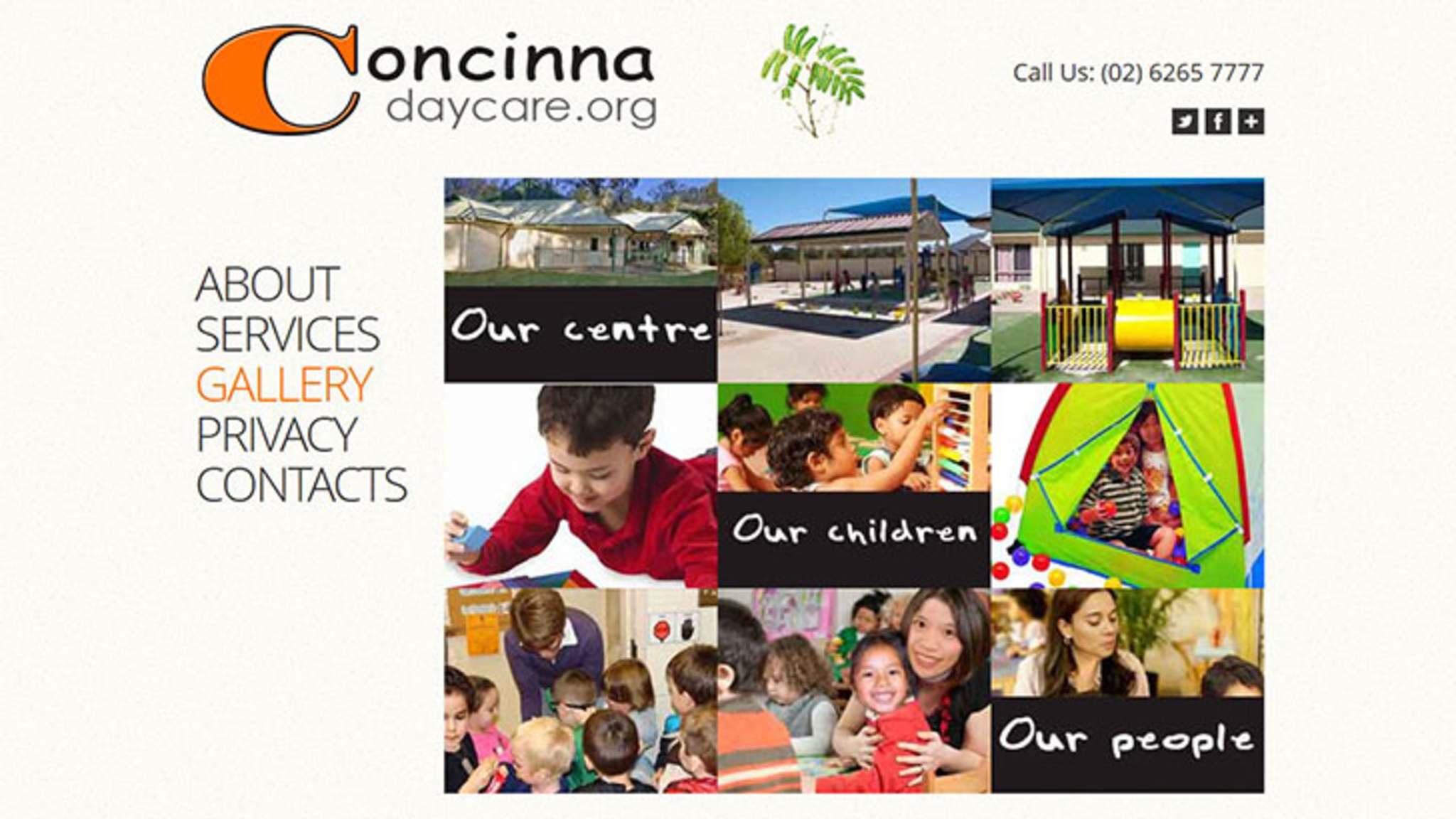 |
Webpage, SMH, 2013 |
- Social engineering can be used to fool staff to give access to a secure system.
- The attacker collects information used for phishing attacks.
Fake childcare website from: Page, F., & Jean, P. (2013, April 16). Free childcare scam aimed at intelligence staff. Sydney Morning Herald. Retrieved from: http://www.smh.com.au/it-pro/security-it/free-childcare-scam-aimed-at-intelligence-staff-20130415-2hwhq.html
Asia Pacific Hypothetical
"At 02:20 Zulu, 1 April 2017, one of our maritime surveillance aircraft was reported missing. The aircraft was conducting a freedom of navigation flyover on one of the reefs, subject to claim by several nations. The last recorded radio transcript … “Mayday, Mayday, Mayday, this is Surveillance One Zero Five Charlie Delta, one zero zero kilometers South East of ... " [Transmission ends]” ...
RAAF P-3 Orion Aircraft,
photo by 'Timothy'
CC BY 2.0, via Wikimedia Commons
It is proposed to target the opposing force's electronic control systems. This is expected to disable electrical systems and cause some local electrical fires. Our intelligence assets in the area will arrange for video of the damage to be posted to social media, for maximum news value. We will be working with civilian government personnel with special expertise, to prepare a human factor attack on their Internet of Things (IoT)."
From Cyberwar: Hypothetical for Teaching ICT Ethics, by Tom Worthington for the course ANU Networked Information Systems, http://www.tomw.net.au/basic_ict_professional_ethics/#ch170077
Cyberweapons
"the purpose of a cyberweapon is to attack an information system in order to perpetrate harm".
Information Warfare Division (IWD),
Australian Department of Defence
From Henschke, A. (2014). A decision-making procedure for responding to cyber-attacks. In M. Keelty, A. Henschke, N. Evans, S. Ford; A Gastineau; L. West, Cybersecurity: mapping the ethical terrain. National Security College (ANU). URL http://nsc.anu.edu.au/documents/ocassional-paper-6-cyber-ethics.pdf
“Offensive Cyber Security operations introduces and exercises a complete range of reverse engineering techniques and attack patterns. Students will also learn and exercise analysis of systems based on minimal information.”
From ANU (2019). Cyber Offensive Operations Course (COMP8502), ANU Handbook. URL https://programsandcourses.anu.edu.au/2019/course/COMP8502
Reponse to Attack
“Credential theft. … four spearphishing emails, to ANU users ...
Compromised infrastructure. The actor built a shadow ecosystem of compromised ANU machines, tools and network connections to carry out their activities undetected. Some compromised machines provide a foothold into the network. Others, like the so-called attack stations, provided the actor with a base of operations to map the network, identify targets of interest, run tools and compromise other machines
Data theft. The actor used a variety of methods to extract stolen data or credentials from the ANU network. This was either via email or through other compromised Internet-facing machines. …”
From: From Incident Report on the Breech of the Australian National University's Administrative Systems, ANU, 2 October, 2019 URL https://imagedepot.anu.edu.au/scapa/Website/SCAPA190209_Public_report_web_2.pdf
Internet of Things
“The Internet of Things is the interconnection via the Internet of computing devices embedded in everyday objects, enabling them to send and receive data.”
Newcastle IoT Coverage,
City of Newcastle 2018
From: From: Council begins roll out of smart city tech, City of Newcastle, 24 Apr 2018. URL https://www.newcastle.nsw.gov.au/Council/News/Latest-News/Council-begins-roll-out-of-smart-city-tech
ps: ANU to run 'cyber bootcamp' for ASEAN officials, By Matt Johnston
IT News, Nov 11 2019
Sunday, November 10, 2019
Autonomous Kei Car Highway
 |
Nissan has announced its Dayz Wider Kei car will be equipped with semi-autonomous assistance with acceleration, steering and braking on the highway.
If such Kei Cars are used, then the width of a standard Australian traffic lane (3.5 m) could carry two lanes of oncoming traffic. Conventional vehicles, such as fire appliances, could use this road, with the oncoming traffic diverted to a passing loop (as is done with railways).
This would greatly reduce the cost of building a highway, as it would only need to be 3.5 m wide for most of its length. Where cost and space are at a premium, and conventional vehicle access is not needed, an even narrower single lane roadway could be used. This would allow bridges and elevated roadways to be quickly built from shipping container sized modules. Tunnels would only need to be about 3 m in diameter.
Monday, November 04, 2019
Information Warfare Division Video
 |
| FOR THE WARFIGHTER |
Sunday, October 20, 2019
Design of computerized system contributed to the death of ten USN sailors
 |
| John S McCain Bridge Control Station. Drawing from IBNS technical manual; color added by NTSB. Figure 4 of NTSB/MAR-19/01 PB2019-100970. |
However, as the NTSB detailed, the crew unintentionally
transferred control of steering from one station to another, but interpreted this as a failure of steering. This confusion may have been because the crew were uncomfortable with the automated mode of the system, and preferred to use the backup manual mode. However the backup mode was not intended for normal use, and allowed the control to be transferred without the operator noticing.
The NTSB recommended crew being instructed to only operate the system in manual mode during an emergency. However, the underlying problem appears to be that the crew did not trust the automated system. This would require training the crew so they felt they could rely on the system, or to redesign the system to provide more intuitive feedback. Part of the intuitive feedback, I suggest, could be via manual controls.
The Bridge Control Stations have a ship's wheel, but this is an input only device, and there are no physical engine throttles, just a GUI display. One way aircraft cockpit interfaces display the operation of the autopilot is by physically moving the throttle levers. Similarly, in aircraft with a control yoke the control moves in response to auto-pilot commands, and also provides tactile and visual feedback of the control responses put in by the co-pilot. The autopilot can be overridden simply by moving the yoke. If implemented on the ships bridge control, this would provide intuitive feedback as to who is in control, and an intuitive way to take control. The operator would be able to see, and feel, inputs through the wheel and throttles. If they wanted to override the automated system, or another operator, they just need to move the controls.
Some modern aircraft lack the visual and tactile feedback in controls, particularly those using side-stick controllers, rather than a yoke. However, in aircraft pilots receive intensive training in the use of these systems, and are sitting close to each other in the cockpit, so are usually able to see and hear what each other are doing. Even so, conflicting inputs have lead to aircraft accidents. On a ship the operators are much further apart, which makes coordination much more difficult.
Reference
Collision between US Navy Destroyer John S McCain and Tanker Alnic MC Singapore Strait, 5 Miles Northeast of Horsburgh Lighthouse
August 21, 2017, Marine Accident Report, National Transportation
Safety Board, NTSB/MAR-19/01 PB2019-100970, Notation 58325
Adopted June 19, 2019 URL https://assets.documentcloud.org/documents/6243999/MAR1901.pdf
Saturday, October 05, 2019
Walgett, Brewarrina, Bourke, Wilcannia and Menindee Lakes
|
I attended the Yaama Ngunna Baaka Corroboree Festival, from 28 September to 2 October, in western NSW. This was by bus from Sydney to Walgett, Brewarrina, Bourke, Wilcannia and Menindee Lakes, then train from Dubbo to Sydney. Mat Ward produced a detailed blog of the trip, there is the Water for the Rivers Facebook Page,
so I will just provide a few reflections of my own.
Sometimes you see a photo, and think: that is not real: it was staged: they added the smoke and colored lights. Well
Mark Merritt's photo of the Corroboree at Wilcannia looks too magical to be real, but I am one of those dots around the circle: that is what it looked like. Leaving early, crossing the old lift bridge over the river to the campsite, I looked back and the moon had risen directly over the ring, the smoke hung low.
While I have written about the problems of telecommunications, and e-learning in regional Australia, this was an academic exercise conducted at a distance. There were two buses, two trucks for supplies, and a convoy of cars. It is rare for me to travel long distances with a large party, and at times voices were raised. But mostly it all worked out.
One highlight were the Brewarrina Fish Traps (Baiame’s Ngunnhu), with a tour by staff from the Brewarrina Aboriginal Cultural Museum. The fist traps may be the oldest existing human made structure.
| Save Our Rivers by Bruce Shillingsworth 2019. |
Update:
Monday, September 16, 2019
Yaama Ngunna Baaka Corroboree Festival 2019
Got my tent, and sleeping bag, ready for the Yaama Ngunna Baaka Corroboree Festival, with local Aboriginal organisations at Walgett, Brewarrina, Bourke, Wilcannia and Menindee Lakes, 28 Sep to 2 Oct 2019. There are a few seats left on the buses: book now.
While I have written about the problems of telecommunications, and e-learning in regional Australia, I am now going to go out and experience it first hand.
"Each dance group will perform in each township at the corroboree that will begin at dusk:
Betina Bysouth (Menindee / Bendigo)
Barkindji (Wilcannia)
Budjiti (Enngonia)
Kamilaroi (Walgett)
Mungundi (Moree)
Murrawari (Goodooga)
Ngemba (Brewarrina)
Wankamurra (Bourke)
Wakagetti (Brewarrina)
Wiradjuri (Trangie)
Also Aboriginal dance groups ...
Garul Giyalu Rock Mob (Katoomba)
Yama Guroo (Sydney)
Koomurri (Sydney)
Tal-Kin-Jeri (Adelaide)
Mujamundu (Quilpie)
Group (Darwin)"
"In Walgett, Brewarrina and Bourke, the Mothers Milk Bank will involve their musicians as part of their Ruby Hunter project ... In Wilcannia and Menindee the duo JOCEAN from Shell Harbour will perform ... The Murray Lower Darling Rivers Indigenous Nations will lead these programs ...
Eva Cannan will lead small ethical foraging bush trips and any food collected will contribute to evening meals. ... In Walgett she will be joined with Elder Camellia Bonney ...
The Indigenous Energy Australia stall will provide information about their leading initiatives...."
Sunday, August 25, 2019
Grapes of Wrath in the Pacific
On Friday I attended a performance of
The Grapes of Wrath at the New Theatre, Sydney. This play is adapted by Frank Galati from John Steinbeck’s novel. As someone in the row behind me kept loudly telling their companion: this play is relentlessly depressing.
This is a relatively straightforward adaption of the book, about tenant farmers driven from the US Midwest by drought and economic depression. The promised land of California, proved not to be paradise with labor contractors conspiring with authorities to exploit itinerant workers.
While well directed, acted and with imaginative set design, I wondered how relevant this story of exploitation in the USA was to Australia today. Then I recalled an Australian politician saying that pacific islanders should not complain about being driven from their land by rising sea levels, as they could always get work picking fruit in Australia.
This is a relatively straightforward adaption of the book, about tenant farmers driven from the US Midwest by drought and economic depression. The promised land of California, proved not to be paradise with labor contractors conspiring with authorities to exploit itinerant workers.
While well directed, acted and with imaginative set design, I wondered how relevant this story of exploitation in the USA was to Australia today. Then I recalled an Australian politician saying that pacific islanders should not complain about being driven from their land by rising sea levels, as they could always get work picking fruit in Australia.
Wednesday, August 21, 2019
GovHack 2019 Launched
Greetings from the Canberra launch of GovHack 2019. This is the tenth year of the GovHack completion where teams have a few days to build an application using open government data. This is hosted by the Australian National University for 2019. It happens have just come from the launch of the Square One co-working space at ANU, next door.
New Reality TV Show Proposed: Geopolitical Survivor
Greetings from the National Gallery of Australia, where I am taking part in "Australia 360", a conference on regional security hosted by the Australian National University. The morning had conventional panels of security experts. The afternoon started with Professor Hugh White's provocative views, in his new book "How to Defend Australia". To make it more interactive we are being polled on questions to do with China, Australia, and the region, with the results displayed on a large screen, and Associate Professor Nicholas Farrelly, as the MC, walking around the floor getting the views of delegates. Professor Rory Medcalf quipped the MC could host a game show called "Geopolitical Survivor". My contribution was to suggest a 360 view should also include the role of India.
"Panel 3: How to defend Australia
This session is an interactive, hands-on component delving into the hard choices Australia has to make about its defence as the world rapidly changes.
Chair Associate Professor Nicholas Farrelly
Associate Dean, College of Asia and the Pacific, ANU
With contributions from Emeritus Professor Hugh White, Strategic and Defence Studies Centre, ANU
Dr Joanne Wallis, Strategic and Defence Studies Centre, ANU
Dave Curran, Chairman, Westpac Scholars Trust
Professor Rory Medcalf, National Security College, ANU
Katherine Mansted, National Security College, ANU"
From Australia 360 Program
Tuesday, August 20, 2019
Memoir from Programmer of the Apollo 11 Lunar Module
The book "Sunburst and Luminary: An Apollo Memoir" by
Don Eyles relates his experience programming the computer on the Apollo Lunar Module. This is a relatively modest first person recounting of someone who fell into computer programming, and ended up on the Apollo program as their first assignment. It would be useful for students who have ambitions of a career in computing to read.
ps: I read the copy in Libraries ACT.
Don Eyles relates his experience programming the computer on the Apollo Lunar Module. This is a relatively modest first person recounting of someone who fell into computer programming, and ended up on the Apollo program as their first assignment. It would be useful for students who have ambitions of a career in computing to read.
"In 1966 the author, newly graduated from college, went to work for the MIT laboratory where the Apollo guidance system was designed. His assignment was to program the complex lunar landing phase in the Lunar Module's onboard computer. As Apollo 11 approaches, the author flies lunar landings in simulators and meets the astronauts who will fly the LM for real. He explains the computer alarms that almost prevented Neil Armstrong from landing and describes a narrow escape from another dangerous problem. On Apollo 14 he devises a workaround when a faulty pushbutton threatens Alan Shepard's mission, earning a NASA award, a story in Rolling Stone, and a few lines in the history books. This memoir is a new kind of book about Apollo. It tells a story never told before by an insider the development of the onboard software for the Apollo spacecraft. It makes a vertical connection between technical details and historic events, but by broadening the story using his own experiences as he grows into adulthood in the 1960s the author draws a parallel between that era of successful space exploration, and the exploration, inner and outer, that was taking place in the culture."
ps: I read the copy in Libraries ACT.
Wednesday, July 31, 2019
Australia Post Digital Identity Service Rescued by Chinese Shoppers After Failure 20 Years Ago?
 |
| Australia Post Digital Identity announcement from 1998 |
In 1998 I applied for an Australia Post "KeyPOST" digital certificate, at a cost of $20. Here is the text from the Australia Post web page of the time:
"Australia Post plays a role in introducing security and trust into transactions performed over the internet. It does this by providing the public (individuals and organisations) with a convenient access point to acquire a digital certificates. KeyPOST is an identity check performed on behalf Certification Authorities.
Digital certificates are now available via the KeyPOST Registration Service, from SecureNet Certificates (SNC). Information and application details for Certification Services provided by SNC are available on the SecureNet Certificates website: www.securenetca.com.au" From "KeyPost", Australia Post, in the Internet Archive, 20 May 2000 |
|||
"Australia Post has decided to cease its KeyPOST(tm) operations concerning the generation of private keys and certificates from 1 August 1999. Unfortunately, the service has not met expectations and its growth and take up rate have been less than what we expected. I would like to thank you for your support and interest in the service, but >it has become increasingly clear that the service is not commercially viable."
From Keypost 1/04/99
Chinese Daigou Use Case
 |
| The daigou channel, by Bang Xiao & Sean Mantesso, ABC News, 31 Jul 2019 |
Hopefully, those at Australia Post planning the new digital identity service have learned from the previous failed service. A use case which might make the new service a success is the multi-billion dollar personal shopper business. Chinese consumers contract 150,000 personal shoppers in Australia (daigou), who are mostly Chinese students, to buy products for them. The Australia Post Digital iD could be used to authenticate the personal shoppers, perhaps in combination with a blockchain. The consumers could be assured who is doing the buying, and they were getting the correct product. The governments could be assured all taxes and duty were being paid.
Friday, July 19, 2019
ACT Renewables Showcase
Program
9:00-9:20 Registration
9:20-9:30 Welcome/Opening
10:00-17:00 Electric Vehicles Exhibition (in partnership with Tesla Owners Club of Australia and Australian Vehicle Association)
9:30-10:15 Panel: Policy Implications for Renewables with Geoffrey Rutledge (ACT Government), Dr Frank Jotzo (ANU), Dr Andreas Loeschel(University of Munster); moderated by Sylvia Tulloch (BAB Chairman for REIF)
10:30-11:45 Workshop: How Green is my Computer? by Tom Worthington.
11:45-12:45 Panel: Women in Renewables with Shahana McKenzie(Bioenergy Australia), Clara Mazzone (ITP Renewables), Alison Reeve (ACT Government), Michelle McCann (PV Lab), Dr Marnie Shaw (ANU); moderated by Ruth O'Connor (ANU)
13:15-14:10 Seminar: Renewable Energy Innovation and World Trends by Simon Corbell (Energy Estate).
14:25-14:50 Speed Talks: Greening the Future-Bioenergy for Transport and Industrial Application by Dr Clive Stephens (Vtara Energy Group).
14:55-15:20 Speed Talks: How Electric Vehicles Could Shape Our World? by Darryl Bourke (Tesla Owners Club of Australia).
15:25-15:50 Speed Talks: Building Blocks of a Sustainable Energy Future by Vincenzo Marciano and Ryan Wood (Evergen).
16:00-16:55 Seminar: State of affairs: Clean Energy Market Challenges by John Grimes (Smart Energy Council).
17:00-17:30 Closing Ceremony closing remarks by Chief Minister Andrew Barr.
From 17:30, Energy Lab will kick off with their famous annual Hackathon. Join us to explore a variety of opportunities that will accelerate the uptake of clean energy. To register for the Hackathon, click here.
You can find tickets at https://www.eventbrite.com.au/e/act-renewables-showcase-2019-tickets-63848147528



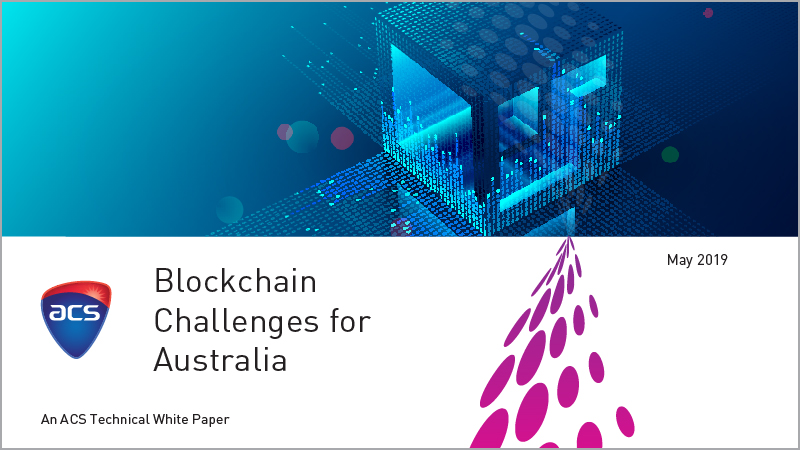


_-_Logo.png/330px-Information_Warfare_Division_(Australian_Department_of_Defence)_-_Logo.png)
